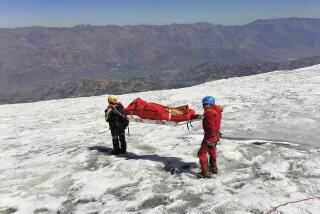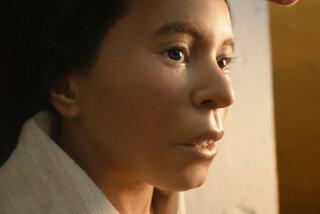3 Mummies of Incan Sacrifice Unearthed
- Share via
Archeologists have unearthed the frozen remains of two girls and a boy at the top of a cloud-swept volcano in the Andes, where Incan priests sacrificed them to the gods five centuries ago.
The mummies are in such good condition that the organs are intact and, in at least one body, it appears that frozen blood still fills the heart.
The 500-year-old children “appear to be the best preserved Inca mummies ever found” and are in better condition than most, if not all, mummies from any period, according to Johan Reinhard, co-leader of the American-Argentine-Peruvian team that made the discovery, which was announced Tuesday. “The arms looked perfect, even down to visible hairs,” he said.
The children were clothed, and the site, found March 16, held an unusually rich collection of undisturbed Incan treasures laid out presumably to appease the mountain gods. The trove included about three dozen gold, silver and shell statues, half of them clothed, as well as bundles of ornate textiles, moccasins and pottery--some still containing food. Found in such unusual plenitude, the artifacts could greatly enhance understanding of the enigmatic Inca empire and particularly its mountain worship, according to independent experts.
“It’s pretty amazing that tissue would stay preserved 500 years, even in a stable environment,” said David Hunt of the Smithsonian Institution, a specialist in skeletal biology and human mummies. He said a glacier might provide the required combination of cold and high humidity.
Researchers have not yet determined the cause of death of the children, who were between age 8 and 14 when they died, Reinhard said. The typical methods of ritual killing were strangulation, live burial and blows to the head, he noted.
Between about 1438 and 1532, the Incas expanded their empire until it occupied a 2,500-mile swath along the Pacific coast of South America, from Colombia to central Chile. Admired for their agriculture, architecture and engineering, the Incas were conquered within three years by the Spanish conquistadors who arrived in 1532.
Reinhard said the mountaintop sacrifice might have been preceded by weeks or months of ritual preparation and exhausting travel, mostly on foot. The volcano summit was at least 124 miles from the nearest Inca village.
The team’s expedition was sponsored by the National Geographic Society.
More to Read
Sign up for Essential California
The most important California stories and recommendations in your inbox every morning.
You may occasionally receive promotional content from the Los Angeles Times.













